Musings
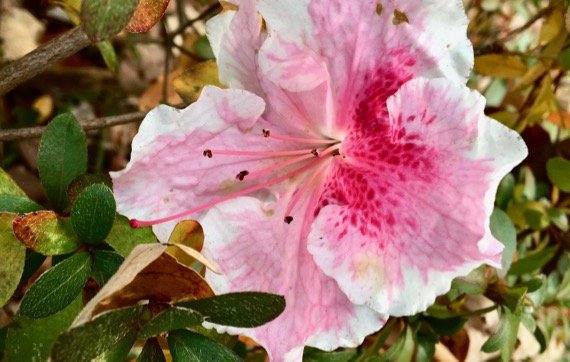
Would you call this a bi-color azalea bloom? Big one, too….
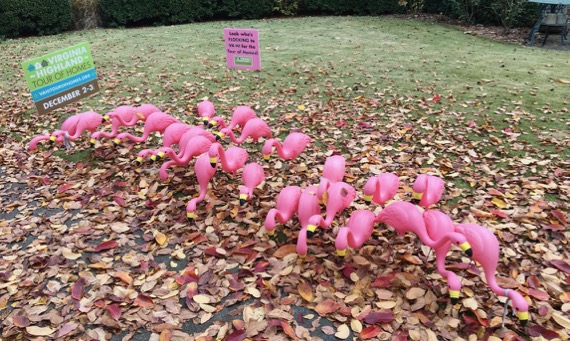
This flock (aka flamboyance or pat or…your term here) of flamingos are to mark the houses on the tour. Or this collection/bunch marks a super-house?
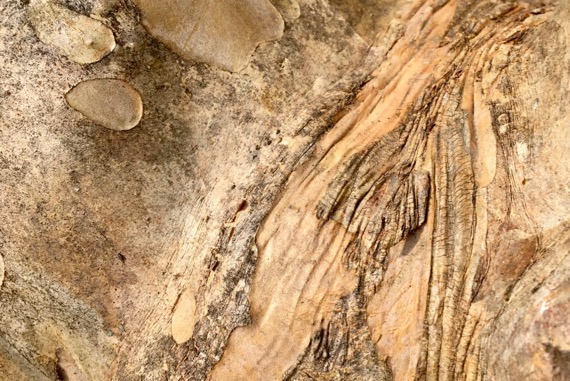
Too much pink? This is crepe myrtle bark, with wrinkles and marks rather like a desert graben.
Posted at 5:53 PM |
Comments Off on Of pink and drab
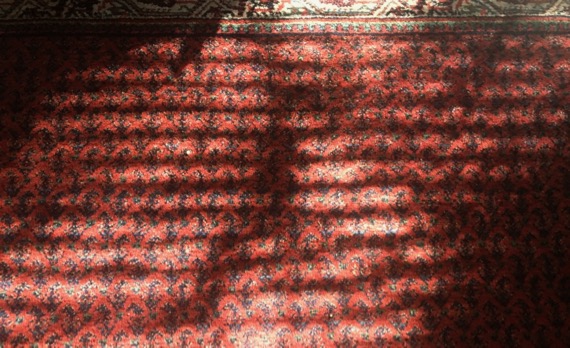
My constant companion these days is medically named paresthesia. It is the sensation mostly on the top of my foot and toes—they feel like they are “asleep.” With a vengeance. Sometimes I call it Pares, and think Paris, as a distraction.
The photo is to symbolize (lamely—haha) the light at the end of the tunnel. Or, “this, too, shall pass.” Something along those lines.
Posted at 10:21 PM |
Comments Off on My paresthesia

We had our own little seasonal moment last night when the JCB dug in the blanket chest and, tada!, we had our first night under the feather duvet. Back in the MiddleAges (exaggeration) when I was a kid, we had quilts and nary a duvet.
Posted at 6:18 PM |
Comments Off on Neither alinea nor pilcrow
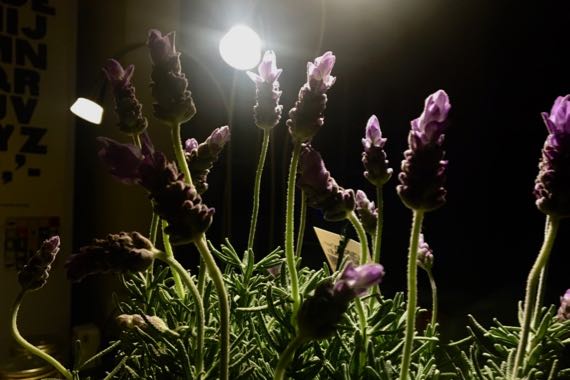
As far back as I remember, I associate lavender with my grandmother. That may well change in the future…and I’ll associate it with my foot-thing….
Nard/nardus was the ancient Greek name….
Posted at 9:23 PM |
Comments Off on Nard, personally
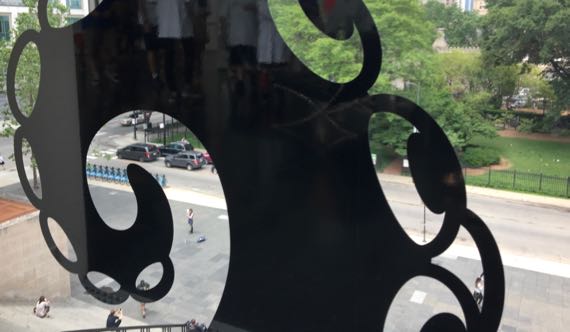
This morning we checked out the Museum of Contemporary Art’s show “Takashi Murakami: The Octopus Eats its Own Leg.” The title comes from a Japanese saying to the effect that an octopus in a mortal jam will eat off its own leg to survive aware that it will soon regrow, with the implication that sacrifice is necessary to create new growth. Kinda gory way to frame that notion…. Murakami was born in 1962.
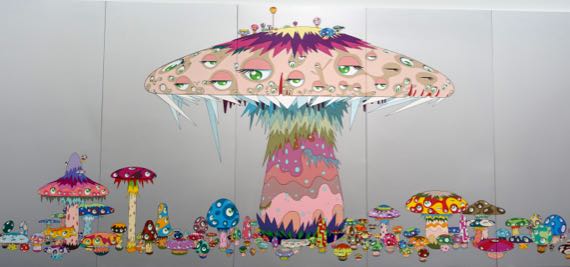
The exhibit shows his pieces in chronological order, and allowed us to see how his art has changed. His sense of color aesthetics is stupendous, and was there at the beginning. This is a 1999 piece he named “Super Nova.” It portrays the world after an atomic bomb…mushrooms are a frequent theme in traditional Japanese art, and of course the bombs make mushroom clouds….

Here’s a detail from a recent multi-panel work, showing more of the influence of anime. Just for this show, we were told, he designed an octopus, used for the promotional materials…you’ll have to find it “out there” if you are interested. Big eyed. Pink.
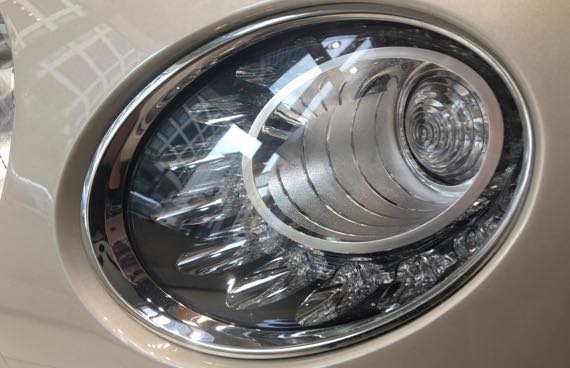
Wandering the streets toward the next stop, we window-shopped Lamborghinis (one headlamp only shown) and Bentleys (even saw a muddy one!—I didn’t know mud stuck to Bentleys!).
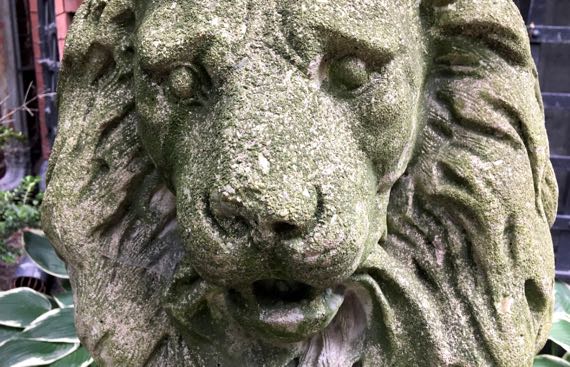
We also wandered by this lion, with a moldy green pelt.

In the broadcasting museum, we unexpectedly found Tim Russert’s “Meet the Press” set.
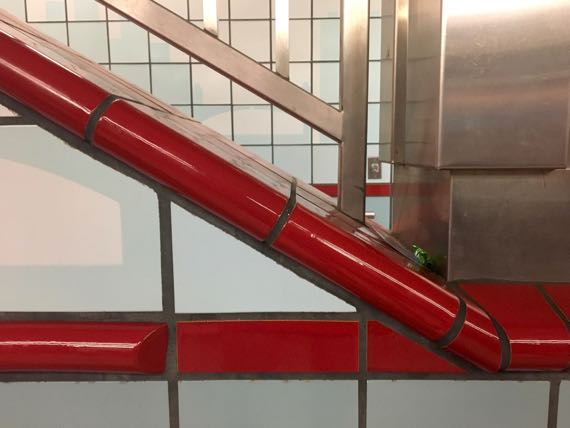
And…we took the subway back to our (temporary) apartment. Beautiful tile work on the walls…public art that mostly goes uncelebrated.
Posted at 8:33 PM |
Comments Off on Octopus eats its leg

I jokingly said this street art was Abe and Mr. Sweater. Turns out it is something like Abe and the Common Man. Common Man being white guy in cable-knit sweater. Nothing against white guys or sweaters. But.

We took a fantastic architectural boat tour, and this was across from our dock. The somewhat unexpected rooftop open-air circular temple can be rented for special occasions.

Our boat went out to the lock that prevents the Chicago River from dumping into the lake—its natural flow—but did not leave the river. Such a great view west of the skyline.

The grass-edged landform to the right was where the Euro-Americans first settled here. They heard the Indians saying something that they distorted into “Chicago” thinking that was the name of the spot. Turns out the Indians were commenting on the marshy vegetation—stinking onions. Or so our wonderful guide said.
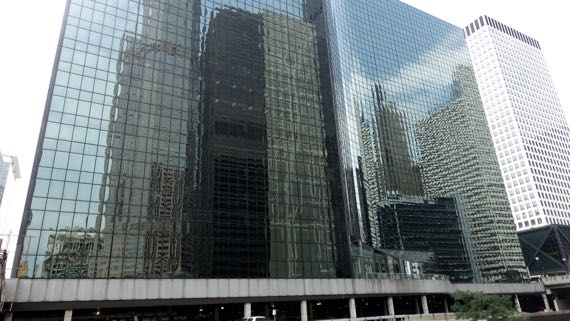
Even more than the building in the previous shot, this one was designed with a plain façade meant to reflect what was around it.

This one, on the other hand, has a stylized map of the rivers. That red “bench” feature way up there indicates the location of this building, a “you are here” marker.

Spotted on our way back from deep-dish pizza engorgement….
Posted at 11:07 PM |
Comments Off on River view
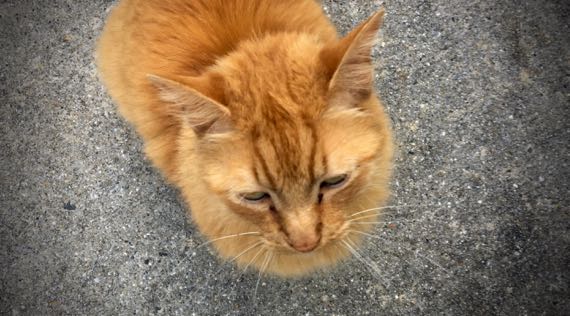
It never occurred to me to think about decoding firewood collection behaviors from the archaeological record—reconstructing species burned from the charcoal/ash, yes, but not all the collecting as a social behavior.
I’m pretty sure Sebastian the Ginger Cat has never thought about firewood.
BTW, the Spanish for firewood is leña. It’s not in the typical travelers’ Spanish vocabulary list. Translations of beer, toilet, laundry, please and thank you, yes—but not firewood.
Posted at 10:48 PM |
Comments Off on Clueless me
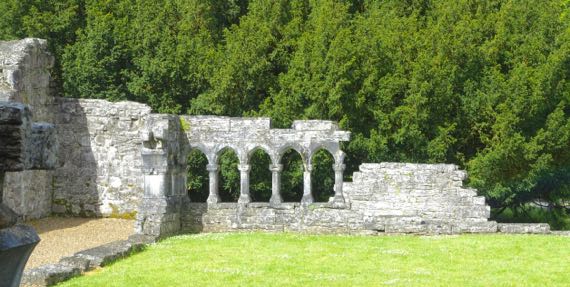
Another day, another religious complex in ruins. Here’s one corner of the cloister interior at Cong Abbey. The Irish is Cúnga Fheichín, meaning St Féchín’s narrows. The narrows refer to the river, I’m guessing. The waterways around the abbey go underground and appear braided. Complex, anyway.
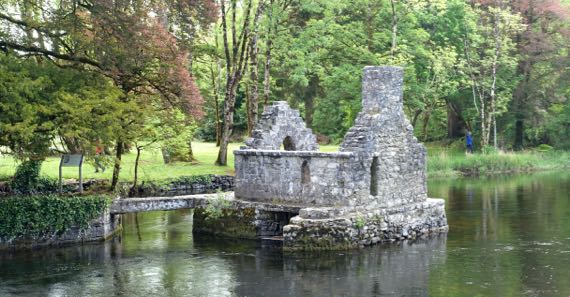
This “fish house” is an unusual surviving monastery feature. My understanding is that the underneath had a net hung inside it, and the fish were retrieved through a trap door in the floor. The area around Cong is where “The Quiet Man” (1952) was filmed–John Wayne and Maureen O’Hara.
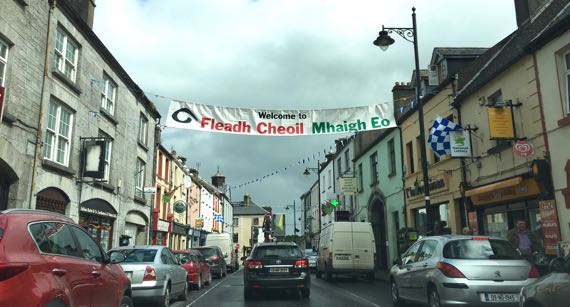
This banner over the street in Ballinrobe says: Welcome to (you got that part, I’m sure) Music Festival Mayo. Mayo is two words in Irish—Mhaigh Eo—which means yew trees, and yew trees are loaded with sacred qualities, very special. Oak trees, too.
Lots of place-names begin Bally– or Balli– like this. The Irish is Baile and it means town, although GooTranslate indicates it means home, also. Interesting cultural implications of that.
Also, place-names that end in –more in English may be from the Irish mór, which means big. Toponyms are such fun!
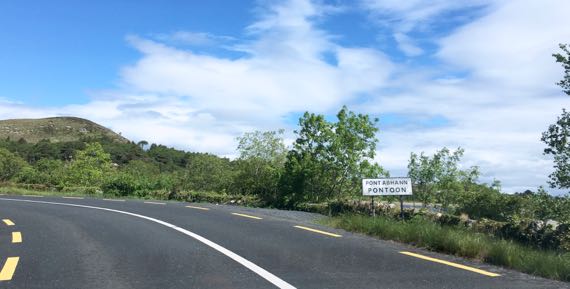
It seems the English mimics the Irish Pont Abhann in some abstract way, as Abhann means river/fluvial and has a different sound than “oon”. Another linguistic abuse by the English….
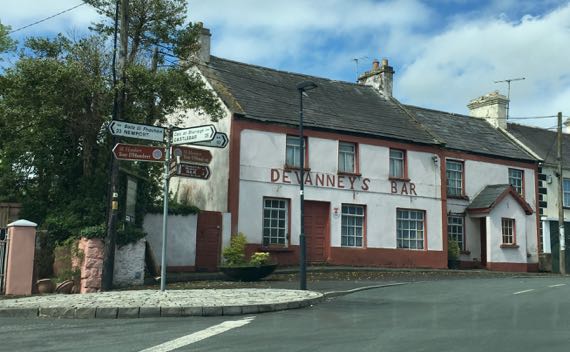
Just liked the way this looked. I couldn’t tell for sure if it is still open.
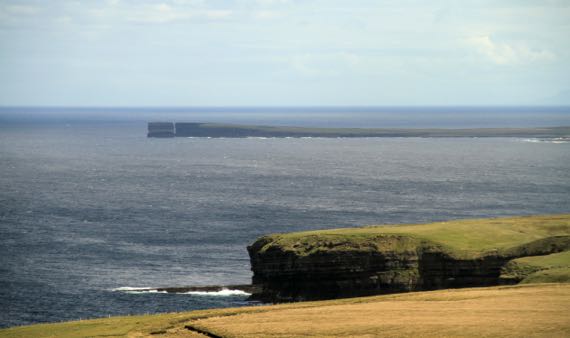
That haystack at the end of this peninsula is Dun Briste, meaning broken fort (fort in the sense that this point is naturally fortified by being almost surrounded by the sea; broken is obvious). The English name highlights something totally different; it is Downpatrick Head.
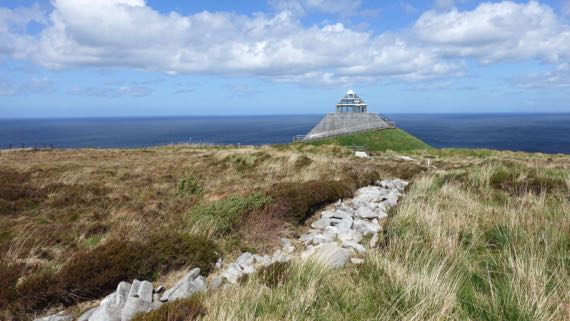
This row of stones exposed from where the peat buried it was a fence-wall thousands of years ago, built by people who cut the forest to begin farming here six millennia ago. Why did peat form here? Scientists aren’t certain, but the current hypothesis is that by cutting the trees, it changed the soil chemistry and created an iron-rich layer that kept the water table high and meant that any plants had to be tolerant of the iron-rich condition to grow, which favored heather and sphagnum and the like. They grew and died and new offspring grew in the same spots, and the moisture and repeated generations meant peat could form.
The large size of the fields and the pollen that has been identified as contemporaneous with the field walls indicate that the fields were pastures, used for cattle and not crops. Very interesting.
Can you guess that it was windy windy windy when we visited Ceíde Fields? Can you guess that is Ceíde pronounced kay-ja? Yup, no “d” at all.
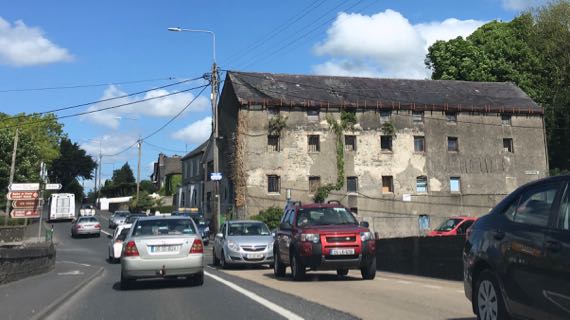
I’m pretty sure this is an abandoned factory. Not all ruins we note are darned old.
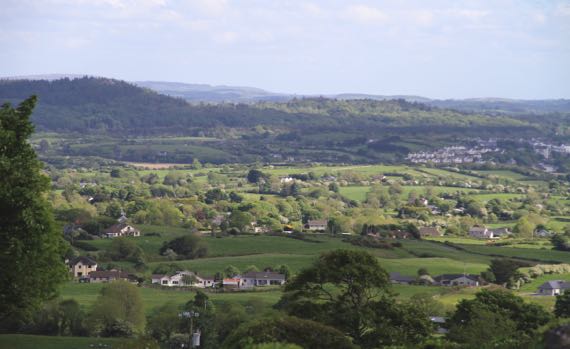
Another high view of the velveteen green, this time with more trees and houses. This is near Sligo, from the flank of the mountain called Cnoc na Riabh, meaning hill of…well, knowledgable people argue about of what. Cnoc is hill, no doubt about it. I keep trying to come up with a Cnoc-Cnoc joke….

And here the tide is out in Sligo. The Irish name of the river (originally) and the town is Sligeach, meaning abundant shells, meaning the river was rich in shellfish, and maybe fish in general. Don’t know about now.
Posted at 3:52 PM |
Comments Off on Irish lessons, subtly
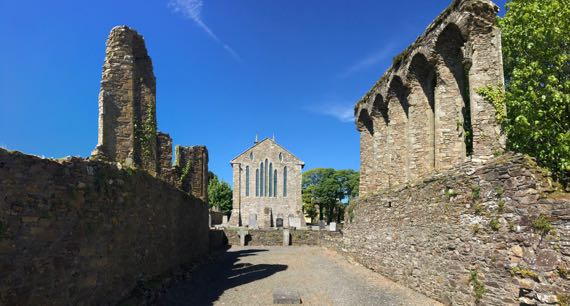
Foreground: ruins of medieval (13th C?) cathedral at Ferns. Five window arches survive on one side, and one on the other. Rear: current mostly 19th-C church.
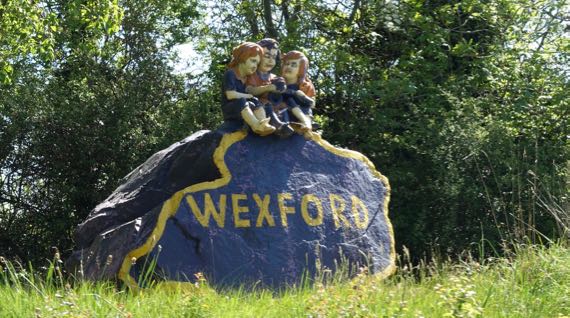
Wexford winsome trio.

Dublin schoolgirls learning about high crosses at heritage park (HP). “Monk” guide did a great job.

The Guru captured a heron and friend in the crannog’s lake at the HP.

Stenciled quote (lines skipped) from Hávamál on wall at HP.

Emo petrol? Killeens swirls?

Tintern Abbey; that is: Tintern Minor abbey. Much modified, but most of “the bones” of what we see is probably 16th C. Used as a residence until 1959.
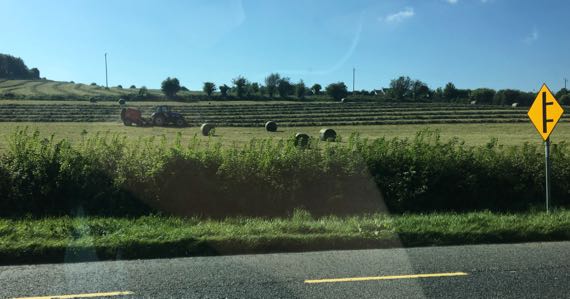
Today was busy-farm-equipment day, including many tractor-rigs on the road. Two days ago, it was paint-your-front-fence day—we saw three being painted and one being pressure-washed‚ none before or since.

I want this label!
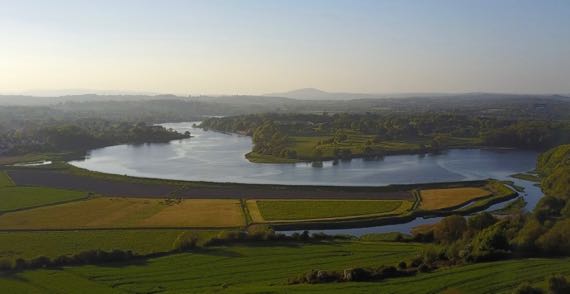
The Guru made Droney fly for the third time here.
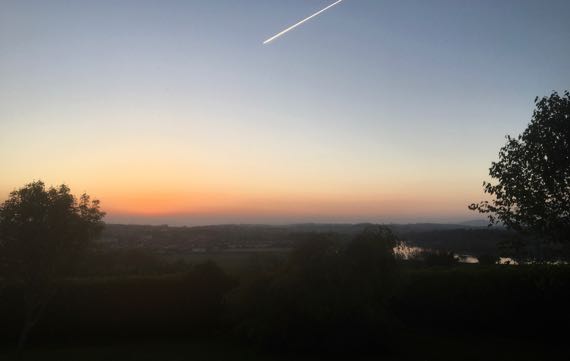
Given that the iPhone darkens a shot like this, you must compensate. I could easily read a book in the ambient light, although it seems darker in this version. This was at 9:02pm. And it’s light out very early, too.
Good night, all.
Posted at 5:07 PM |
2 Comments »
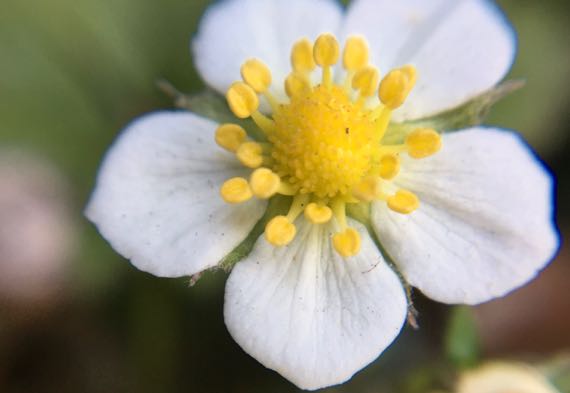
I told the Guru I wasn’t going to write much today…so, mostly photos. Wild strawberry.

Holsteins arriving at fence at end of new pasture area. Bawling. This is atop an early medieval place of major importance called Uisneach. The scale of the hilltop with scattered features was difficult to grasp even standing there. Just think of it as the cattle site.

Our access to the hilltop passed by this somewhat mysterious cattle management structure.
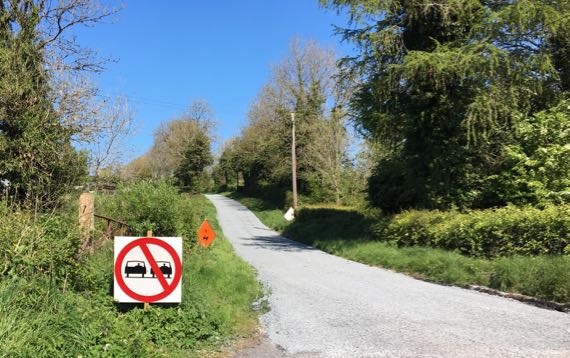
I laughed that someone thought it necessary to mark this one-and-a-half lane road with an aon scoitheadh sign—no passing.
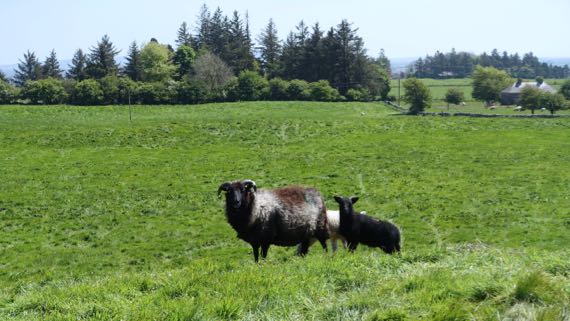
I’m standing on another major architectural feature. Me and this momma sheep and her two babes, one black, one white. Think of it as the sheep site. The formal name is Rathcroghan.
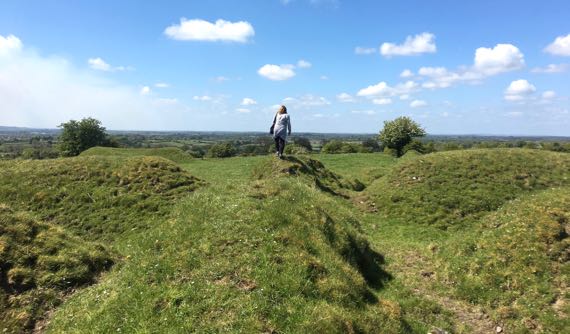
I guess this one might be the person site? It’s called Rathra, and I think this is an old field boundary cutting through the early medieval ring fort. It has two pairs of wall-ditch combos to my left and right. Also you can see a barrow mound just visible over the walls to my left. Darned exciting.
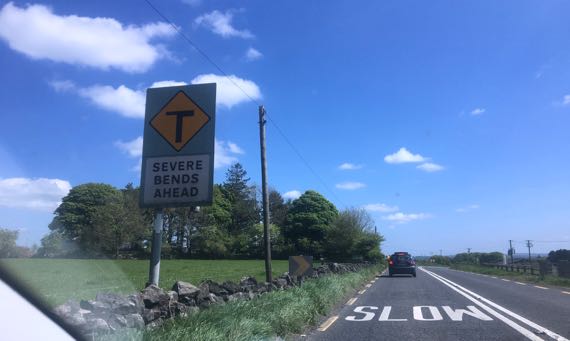
We laughed at this sign. Crappy snapshot, however.

We stopped at the famous monastery ruin named Clonmacnoise. Here’s a view of the oldest structure here (foreground), called Temple Ciarán. It dates to the 8th/9th C, and is considered among the earliest mortared stone shrine chapels in Ireland. That’s the Shannon River in the background; there was a bridge across it as early as ~804. The Guru sent Drony on a mission here getting a great view of a nearby 1214 Anglo-Norman motte-and-bailey castle ruin on the riverbank.

We happened upon turves of peat drying. These are regular shapes from mechanized harvesting. Several (parts of) bog people have been found during such operations.

This abandoned factory is the town of Clara. We spotted another one, too. On the way into town, we drove by the ruins of a monastery. St Brigid founded the original wooden monastery, records indicate. Clara seems pretty resilient; keep on biking.
Posted at 4:27 PM |
Comments Off on Aon scoitheadh



















































